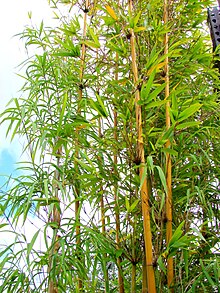Bambusa textilis: Difference between revisions
| Line 20: | Line 20: | ||
==Cultivation== |
==Cultivation== |
||
It is cultivated in particular to constitute [[hedge]]s or privacy screens in suburban yards and can be planted in subtropical/tropical gardens where it can complement |
It is cultivated in particular to constitute [[hedge]]s or privacy screens in suburban yards and can be planted in subtropical/tropical gardens where it can complement the native rainforest flora, and as well as in [[garden bed]]s near a fence. It can also provide both noise and [[wind break]]. The variety ''var. gracilis'' is one of the most popular bamboos, especially in Australia, which is known as ''Gracilis bamboo'', that forms a sightly clump.<ref>[https://www.bhg.com.au/the-best-of-clumping-bamboo#:~:text=Slender%20weavers%20One%20of%20the,a%20privacy%20screen%20or%20hedge. The best of clumping bamboo] [[Better Homes and Gardens (TV program)|Better Homes and Gardens]]</ref> |
||
Non-invasive, it will tolerate winds and as well cold temperatures down to -10°C. It grow best in full sun to part shade, and it may benefit from some [[mulch]] and [[nitrogen]] fertiliser.<ref>[https://www.alpinenurseries.com.au/plant-library/bambusa-textilis-gracilis/#:~:text=A%20fast%20growing%2C%20tall%2C%20straight,facilitate%20its%20natural%20base%20size. Bambusa textilis Gracilis Slender Weavers Bamboo] Alpine Nurseries</ref> |
Non-invasive, it will tolerate winds and as well cold temperatures down to -10°C. It grow best in full sun to part shade, and it may benefit from some [[mulch]] and [[nitrogen]] fertiliser.<ref>[https://www.alpinenurseries.com.au/plant-library/bambusa-textilis-gracilis/#:~:text=A%20fast%20growing%2C%20tall%2C%20straight,facilitate%20its%20natural%20base%20size. Bambusa textilis Gracilis Slender Weavers Bamboo] Alpine Nurseries</ref> |
||
Revision as of 07:23, 25 August 2020
| Bambusa textilis | |
|---|---|

| |
| Scientific classification | |
| Kingdom: | Plantae |
| Clade: | Tracheophytes |
| Clade: | Angiosperms |
| Clade: | Monocots |
| Clade: | Commelinids |
| Order: | Poales |
| Family: | Poaceae |
| Genus: | Bambusa |
| Species: | B. textilis
|
| Binomial name | |
| Bambusa textilis | |
| Synonyms | |
|
Bambusa varioaurita W.T.Lin & Z.J.Feng | |
Bambusa textilis, also known as slender bamboo, clumping bamboo and weaver's bamboo, is a species of bamboo in the Poaceae (grasses) family that is native to China. The subspecies var. gracilis is heavily cultivated in Australia.[1]
Description

Slender bamboo is a giant, densely leaved, upright bamboo, that grows in a tight clump up to 6 to 10 meters high and 2 meters in width at a fast rate (with gracilis subspecies growing no more than 8 metres high) and has a stem size of 3cm.
Having elegant leaves and greenish blue-hued culm that is glossy and leathery, its long green internodes change to yellow during prolonged sunlight exposure. Despite being an evergreen, some leaf loss can be expected in winter, but this depends on the location and microclimate.[2]
Distribution
In its native southern China, it usually found near rivers and villages at low altitudes in the Anhui, Guangdong and Guangxi provinces. It is also native to Vietnam.[3] It has been naturalized in Hawaii, Florida, Colombia and Puerto Rico.[4]
Cultivation
It is cultivated in particular to constitute hedges or privacy screens in suburban yards and can be planted in subtropical/tropical gardens where it can complement the native rainforest flora, and as well as in garden beds near a fence. It can also provide both noise and wind break. The variety var. gracilis is one of the most popular bamboos, especially in Australia, which is known as Gracilis bamboo, that forms a sightly clump.[5]
Non-invasive, it will tolerate winds and as well cold temperatures down to -10°C. It grow best in full sun to part shade, and it may benefit from some mulch and nitrogen fertiliser.[6]
Varieties
- B. textilis var. glabra
- B. textilis var. gracilis
- B. textilis var. maculata
- B. textilis var. textilis
References
- ^ Bambusa textilis var. gracilis Common Names: Gracilis, Slender Weavers Living Bamboo Production Nursery
- ^ Bambusa textilis - McClure Plants for a Future
- ^ Bambusa textilis McClure, Lingnan Univ. Sci. Bull. 9: 14. 1940. Flora of China
- ^ Bambusa textilis Pacific Island Ecosystems at Risk (PIER)
- ^ The best of clumping bamboo Better Homes and Gardens
- ^ Bambusa textilis Gracilis Slender Weavers Bamboo Alpine Nurseries
Sources
- "Bambusa textilis McClure". Catalogue of Life. Species 2000: Leiden, the Netherlands.
- "Bambusa textilis". Flora of China – via eFloras.org, Missouri Botanical Garden, St. Louis, MO & Harvard University Herbaria, Cambridge, MA.
- "Bambusa textilis McClure (1940)". World Checklist of Selected Plant Families (WCSP). Royal Botanic Gardens, Kew.
- "Bambusa textilis McClure". World Checklist of Selected Plant Families. Royal Botanic Gardens, Kew – via The Plant List. Note that this website has been superseded by World Flora Online
- "Bambusa textilis McClure". Tropicos. Missouri Botanical Garden.
- "Bambusa textilis McClure, 1940". Universal Biological Indexer and Organizer (UBIO).
